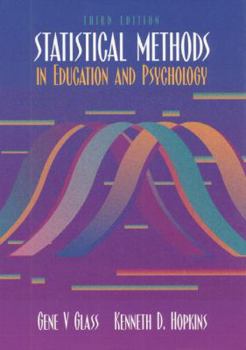Statistical Methods in Education and Psychology
Select Format
Select Condition 
Book Overview
The approach of SMEP-III is conceptual rather than mathematical. The authors stress the understanding, applications, and interpretation of concepts rather than derivation and proof or... This description may be from another edition of this product.
Format:Hardcover
Language:English
ISBN:0205142125
ISBN13:9780205142125
Release Date:August 1995
Publisher:Allyn & Bacon
Length:674 Pages
Weight:2.65 lbs.
Dimensions:1.4" x 7.3" x 9.6"
Customer Reviews
4 ratings
Explanative / helpful, yet not much used
Published by Thriftbooks.com User , 15 years ago
This is a decent book, with many helpful explanations and examples, but I actually never need it except for the table of z-scores in the back, because my instructor provides all the necessary notes in class.
Lay stat. student finds the book very good.
Published by Thriftbooks.com User , 20 years ago
It is amazing to read other reviews, and it became clear how we all come from varied perspectives and view things differently. I have read couple of statistics books trying to understand one thing or the other before, and have not been lucky finding a real fair text (no stat book could really be a jelly anyway!!!). However, I had the hard luck of doing stats for my M.Sc program...and G & H has been wonderful. I can't complain at all. This text is truly great...and note that I am not a prof. So, if non-profs and lay stat. takers like me could benefit from the book...then it is pretty good.
Of course you won't like it ... it's STATS!
Published by Thriftbooks.com User , 21 years ago
G & H is a GOOD book. I have taught graduate students using several editions of this book for many years (David Howell's book is good too). The primary advantage of this book is that it does NOT contain a great many errors. Maybe there are some typos but at least it does not give bad and incorrect advice. This is not true of many books geared toward non-statistics students. I have to say that students do not like the book. They think it is too hard. They want something easy and COMPLETELY non-technical (and this book is not really very technical), If students are going to learn the material, which is by its nature technical, the book has to be somewhat technical. I try to ease the tedium by supplementing the book with MANY handout and other materials. For what it is the _Cartoon Guide to Statistics_ is actually pretty good and also not full of errors. This latter book is a good supplement to G & H. The cartoons add some fun but G & H is not really much more technical. My advice to students is to go to the library and find lots of different stats books. Everyone learns differently and find one that helps you. Be aware though that the non-technical, really simple books tend to be written by people who don't know what they are talking about and so it's the blind-leading-the-blind. The best way to survive stats is to study every day. If you don't understand something find your prof or ta and have them explain it until you get it. Good luck & persevere!
an enduring classic
Published by Thriftbooks.com User , 24 years ago
When the first edition (Glass and Stanley) appeared, in 1970, it was widely acclaimed as the most readable treatment of these methods. Despite the appearance since then of numerous competitors, it has held up well. I can follow a much more mathematical treatment, but this is still the best explanation of what to do when -- and WHY. Perhaps it's confusing to those who only want to know how to do procedures -- but then they have to ask someone else what procedures to use. This book takes the reader a long way toward real insight into statistical thinking.






